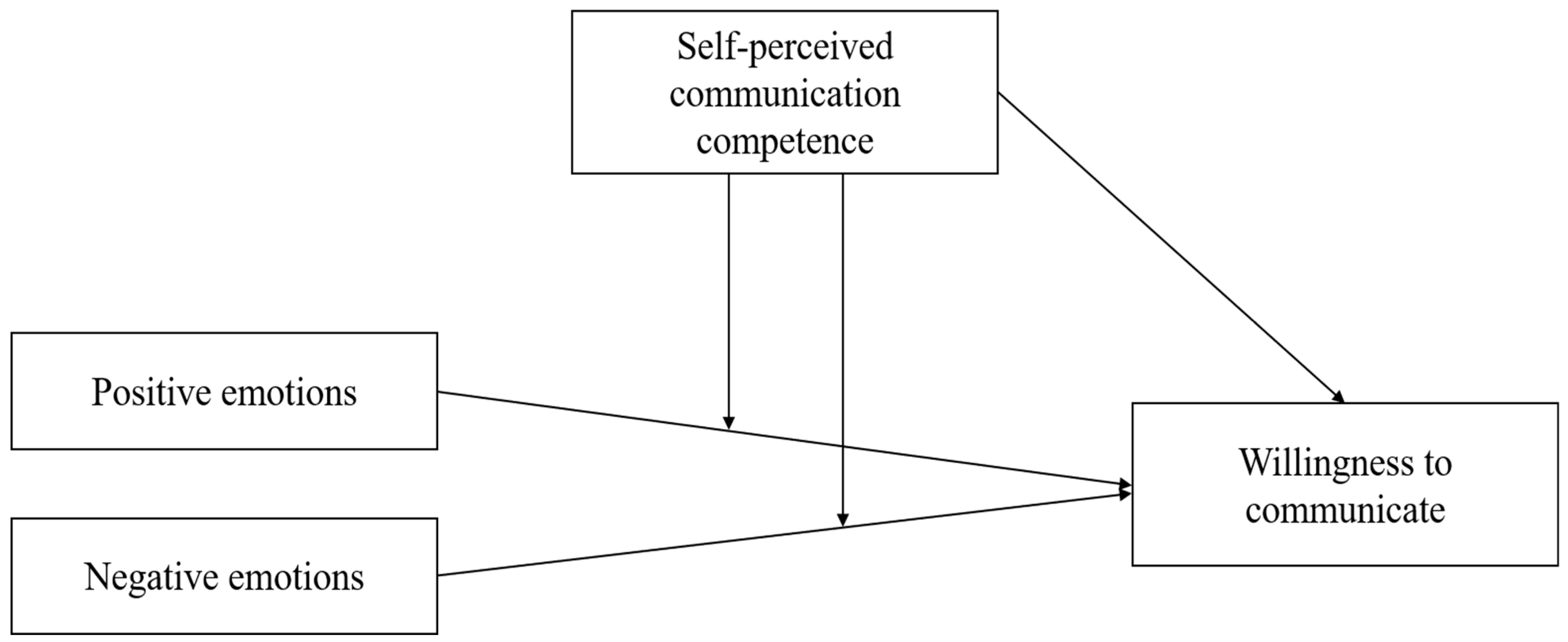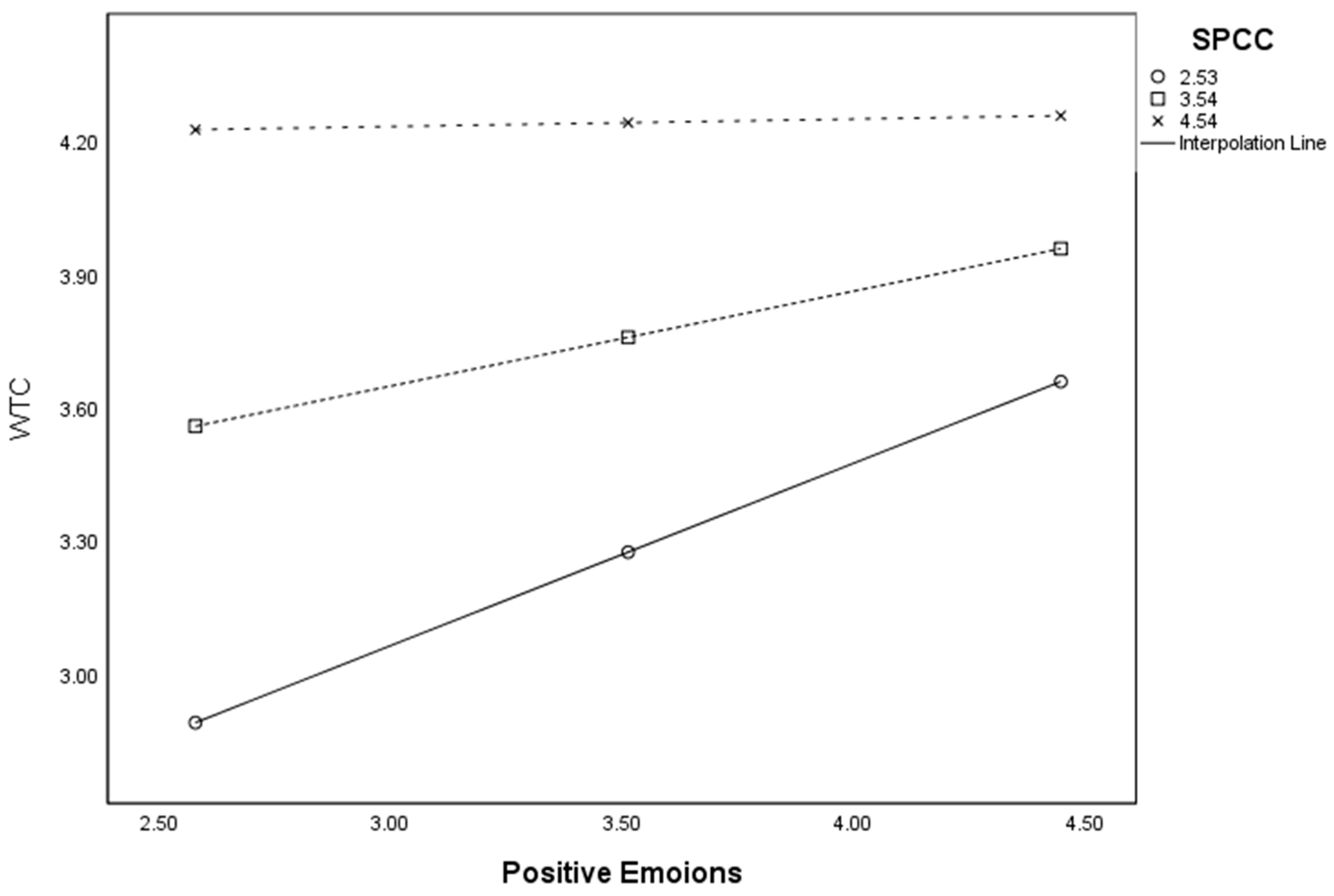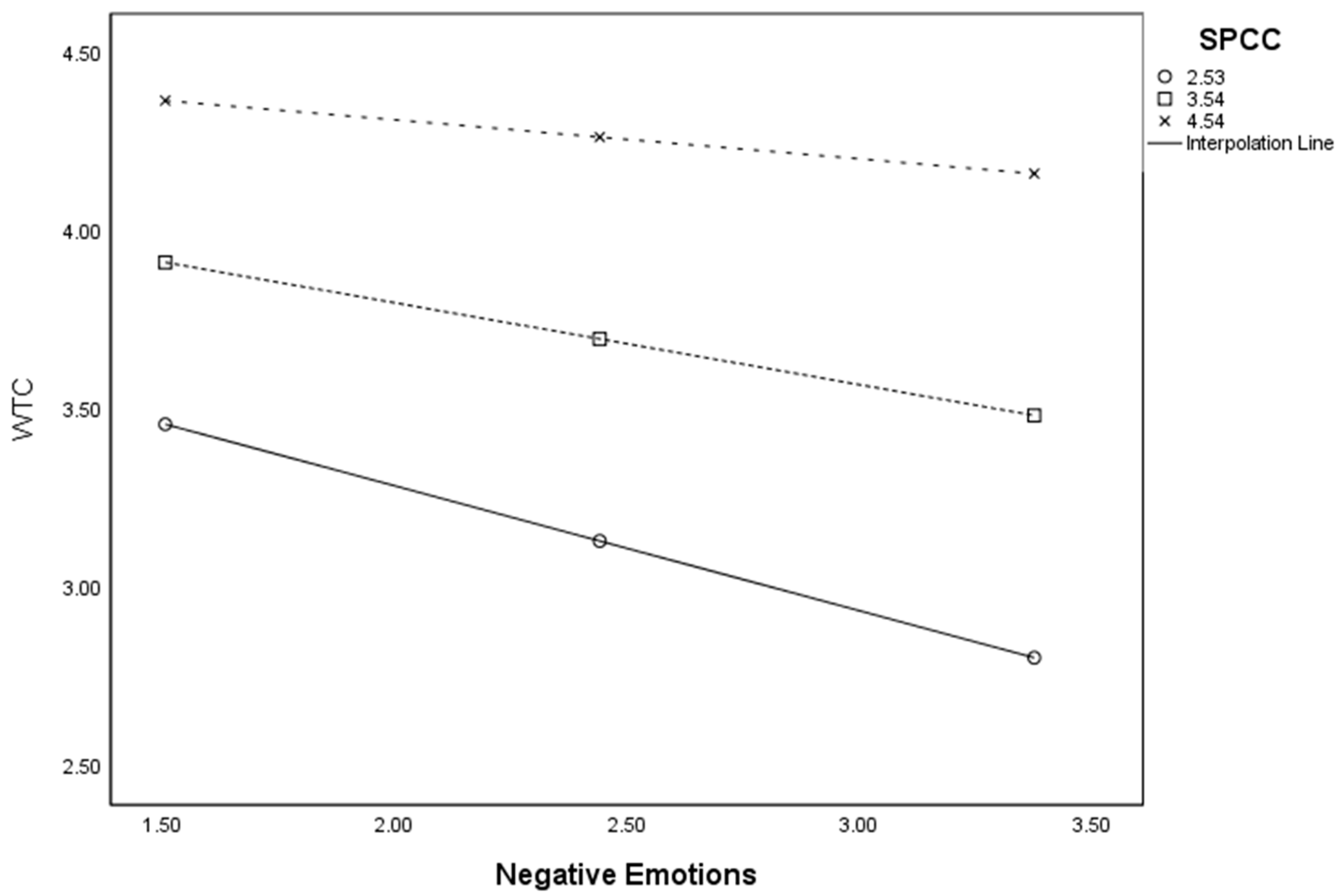The Role of Positive and Negative Emotions in Shaping Willingness to Communicate in a Second Language: Self-Perceived Communication Competence as a Moderator
Abstract
1. Introduction
2. Literature Review
2.1. Willingness to Communicate (WTC)
2.2. Emotions
2.2.1. Positive Emotions
2.2.2. Negative Emotions
2.3. Self-Perceived Communication Competence (SPCC)
2.4. Moderating Effect of Self-Perceived Communication Competence
2.5. Broaden-and-Build Theory
3. Methods
3.1. Participants
3.2. Measurement
3.2.1. Emotions (Positive and Negative)
3.2.2. Self-Perceived Communication Competence (SPCC)
3.2.3. Willingness to Communicate (WTC)
4. Results
5. Discussion
6. Conclusions
Author Contributions
Funding
Institutional Review Board Statement
Informed Consent Statement
Data Availability Statement
Conflicts of Interest
References
- Syed, H.; Kuzborska, I. Dynamics of factors underlying willingness to communicate in a second language. Lang. Learn. J. 2020, 48, 481–500. [Google Scholar] [CrossRef]
- MacIntyre, P.D.; Clément, R.; Dörnyei, Z.; Noels, K.A. Conceptualizing willingness to communicate in a L2: A situational model of L2 confidence and affiliation. Mod. Lang. J. 1998, 82, 545–562. [Google Scholar] [CrossRef]
- Syed, H.A.S. Dynamics of Variables Underlying Willingness to Communicate (WTC) in English (L2): A Case Study of Postgraduate Business Students at a University Classroom in Sukkur, Pakistan. Ph.D. Dissertation, University of York, York, UK, 2016. [Google Scholar]
- Mahmoodi, M.H.; Moazam, I. Willingness to communicate (WTC) and L2 achievement: The case of Arabic language learners. Procedia-Soc. Behav. Sci. 2014, 98, 1069–1076. [Google Scholar] [CrossRef]
- Shirvan, M.E.; Khajavy, G.H.; MacIntyre, P.D.; Taherian, T. A meta-analysis of L2 willingness to communicate and its three high evidence correlates. J. Psycholinguist. Res. 2019, 48, 1241–1267. [Google Scholar] [CrossRef]
- Dewaele, J.M.; MacIntyre, P.D. The two faces of Janus? Anxiety and enjoyment in the foreign language classroom. Stud. Second Lang. Learn. Teach. 2014, 4, 237–274. [Google Scholar] [CrossRef]
- Khajavy, G.H.; MacIntyre, P.D.; Barabadi, E. Role of the emotions and classroom environment in willingness to communicate: Applying doubly latent multilevel analysis in second language acquisition research. Stud. Second Lang. Acquis. 2018, 40, 605–624. [Google Scholar] [CrossRef]
- Dewaele, J.M.; Pavelescu, L.M. The relationship between incommensurable emotions and willingness to communicate in English as a foreign language: A multiple case study. Innov. Lang. Learn. Teach. 2021, 15, 66–80. [Google Scholar] [CrossRef]
- Alemi, M.; Daftarifard, P.; Pashmforoosh, R. The impact of language anxiety and language proficiency on WTC in EFL context. Cross-Cult. Commun. 2011, 7, 150–166. [Google Scholar] [CrossRef]
- Shahbaz, M.; Khan, M.S.; Khan, R.M.I.; Mustafa, G. Role of self-perceived communication competence and communication apprehension for willingness to communicate in L1 and L2. J. Educ. Soc. Res. 2016, 6, 158. Available online: http://www.richtmann.org/journal/index.php/jesr/article/view/8791 (accessed on 1 August 2023). [CrossRef][Green Version]
- Croucher, S.M. Communication apprehension, self-perceived communication competence, and willingness to communicate: A French analysis. J. Int. Intercult. Commun. 2013, 6, 298–316. [Google Scholar] [CrossRef]
- Dewaele, J.M.; Dewaele, L. Learner-internal and learner-external predictors of willingness to communicate in the FL classroom. J. Eur. Second Lang. Assoc. 2018, 2, 24–37. [Google Scholar] [CrossRef]
- Yashima, T.; MacIntyre, P.D.; Ikeda, M. Situated willingness to communicate in an L2: Interplay of individual characteristics and context. Lang. Teach. Res. 2018, 22, 115–137. [Google Scholar] [CrossRef]
- Fatima, I.; Ismail, S.A.M.M.; Pathan, Z.H.; Memon, U. The power of openness to experience, extraversion, L2 self-confidence, classroom environment in predicting L2 willingness to communicate. Int. J. Instr. 2020, 13, 909–924. [Google Scholar] [CrossRef]
- Ali, M.S.; Pathan, Z.H. Exploring factors causing demotivation and motivation in learning English language among college students of Quetta, Pakistan. Int. J. Engl. Linguist. 2017, 7, 81–89. [Google Scholar] [CrossRef]
- Bahadori, M.; Hashemizadeh, S.M. Relationship among self-perceived oral competence, communication apprehension, and Iranian EFL learners’ willingness to communicate: Cooperative teaching in focus. Int. J. Foreign Lang. Teach. Res. 2018, 6, 75–96. Available online: http://jfl.iaun.ac.ir/article_597426.html (accessed on 1 August 2023).
- Lee, J.S.; Sylvén, L.K.; Lee, K. Cross-cultural insights into Korean and Swedish secondary school students’ willingness to communicate in a second language. J. Multi. Multicult. Dev. 2020, 42, 522–536. [Google Scholar] [CrossRef]
- MacIntyre, P.D. Willingness to communicate in the second language: Understanding the decision to speak as a volitional process. Mod. Lang. J. 2007, 91, 564–576. [Google Scholar] [CrossRef]
- Yashima, T. Willingness to communicate in a second language: The Japanese EFL context. Mod. Lang. J. 2002, 86, 54–66. [Google Scholar] [CrossRef]
- McCroskey, J.; Richmond, V.P. Willingness to communicate. In Personality and Interpersonal Communication; McCroskey, J.C., Delay, J.A., Eds.; SAGE: Newbury Park, CA, USA, 1987; pp. 1–156. [Google Scholar]
- McCroskey, J.C.; Richmond, V.P. Quiet Children and the Classroom: Teacher ERIC Clearinghouse on Reading and Communication Skills, 2nd ed.; Speech Communication Association: Cambridge, MA, USA, 1991. [Google Scholar]
- Li, C.; Xu, J. Trait emotional intelligence and classroom emotions: A positive psychology investigation and intervention among Chinese EFL learners. Front. Psychol. 2019, 10, 2453. [Google Scholar] [CrossRef]
- Kövecses, Z. Conceptualizing emotions. A revised cognitive linguistic perspective. Pozn. Stud. Contemp. Linguist. 2014, 50, 15–28. [Google Scholar] [CrossRef]
- Reeve, J. Understanding Motivation and Emotion, 6th ed.; Wiley: Hoboken, HL, USA, 2015. [Google Scholar]
- Dewaele, J.M.; Li, C. Editorial: Special issue ‘Emotions in SLA’. Stud. Second Lang. Learn. Teach. 2018, 8, 15–19. [Google Scholar] [CrossRef]
- Dewaele, J.M. The effect of classroom emotions, attitudes toward English, and teacher behavior on willingness to communicate among English foreign language learners. J. Lang. Soc. Psychol. 2019, 38, 523–535. [Google Scholar] [CrossRef]
- Fredrickson, B.L. Positive emotions broaden and build. In Advances in Experimental Social Psychology; Academic Press: Cambridge, MA, USA, 2013; Volume 47, pp. 1–53. [Google Scholar] [CrossRef]
- Dornyei, Z.; Ryan, S. The Psychology of the Language Learner Revisited; Routledge: Lodon, UK, 2015. [Google Scholar]
- Fredrickson, B.L. Cultivated emotions: Parental socialization of positive emotions and self-conscious emotions. Psychol. Inq. 1998, 9, 279–281. [Google Scholar] [CrossRef]
- Ryff, C.D.; Singer, B. The contours of positive human health. Psychol. Inq. 1998, 9, 1–28. [Google Scholar] [CrossRef]
- Fredrickson, B.L.; Cohn, M.A. Positive emotions. In Handbook of Emotions; Lewis, M., Haviland-Jones, J.M., Barrett, L.F., Eds.; The Guilford Press: New York, NY, USA, 2008; pp. 777–796. [Google Scholar]
- Fredrickson, B.L. The broaden–and–build theory of positive emotions. Philosophical Transactions of the Royal Society of London. Biol. Sci. 2004, 359, 1367–1377. [Google Scholar] [CrossRef]
- Dewaele, J.M. On emotions in foreign language learning and use. Lang. Teach. 2015, 39, 13–15. [Google Scholar] [CrossRef]
- Zembylas, M.; Charalambous, C.; Charalambous, P. The schooling of emotion and memory: Analyzing emotional styles in the context of a teacher’s pedagogical practices. Teach. Teach. Educ. 2014, 44, 69–80. [Google Scholar] [CrossRef]
- Cao, Y. A sociocognitive perspective on second language classroom willingness to communicate. TESOL Q. 2014, 48, 789–814. [Google Scholar] [CrossRef]
- MacIntyre, A.C. Dependent Rational Animals: Why Human Beings Need the Virtues; Open Court Publishing: Chicago, IL, USA, 1999. [Google Scholar]
- Khodadady, E.; Khajavy, G.H. Exploring the role of anxiety and motivation in foreign language achievement: A structural equation modeling approach. Porta Linguarum 2013, 20, 269–286. [Google Scholar] [CrossRef]
- Khajavy, G.H.; Ghonsooly, B.; Hosseini Fatemi, A.; Choi, C.W. Willingness to communicate in English: A microsystem model in the Iranian EFL classroom context. TESOL Q. 2016, 50, 154–180. [Google Scholar] [CrossRef]
- MacIntyre, P.D.; Baker, S.C.; Clément, R.; Donovan, L.A. Sex and age effects on willingness to communicate, anxiety, perceived competence, and L2 motivation among junior high school French immersion students. Lang. Learn. 2002, 52, 537–564. [Google Scholar] [CrossRef]
- Pekrun, R.; Goetz, T.; Frenzel, A.C.; Barchfeld, P.; Perry, R.P. Measuring emotions in students’ learning and performance: The Achievement Emotions Questionnaire (AEQ). Contemp. Educ. Psychol. 2011, 36, 36–48. [Google Scholar] [CrossRef]
- Pekrun, R.; Goetz, T.; Titz, W.; Perry, R.P. Academic emotions in students’ self-regulated learning and achievement: A program of qualitative and quantitative research. Educ. Psychol. 2002, 37, 91–105. [Google Scholar] [CrossRef]
- MacIntyre, P.D.; Mercer, S. Introducing positive psychology to SLA. Stud. Second Lang. Learn. Teach. 2014, 4, 153–172. [Google Scholar] [CrossRef]
- Baker, S.C.; MacIntyre, P.D. The role of gender and immersion in communication and second language orientations. Lang. Learn. 2000, 50, 311–341. [Google Scholar] [CrossRef]
- Lockley, T. Exploring self-perceived communication competence in foreign language learning. Stud. Second Lang. Learn. Teach. 2013, 3, 187–212. [Google Scholar] [CrossRef]
- Kim, S.J. Exploring Willingness to Communicate (WTC) in English among Korean EFL (English as a Foreign Language) Students in Korea: WTC as a Predictor of Success in Second Language Acquisition. Ph.D. Dissertation, The Ohio State University, Columbus, OH, USA, 2004. Available online: http://rave.ohiolink.edu/etdc/view?acc_num=osu1101267838 (accessed on 1 August 2023).
- Teven, J.J.; Richmond, V.P.; McCroskey, J.C.; McCroskey, L.L. Updating relationships between communication traits and communication competence. Commun. Res. Rep. 2010, 27, 263–270. [Google Scholar] [CrossRef]
- Derryberry, D.; Tucker, D.M. Motivating the focus of attention. In The Heart’s Eye: Emotional Influences in Perception and Attention; Niedenthal, P.M., Kitayama, S., Eds.; Academic Press: Cambridge, MA, USA, 1994; pp. 167–196. [Google Scholar] [CrossRef]
- Cao, Y. Investigating situational willingness to communicate within second language classrooms from an ecological perspective. System 2011, 39, 468–479. [Google Scholar] [CrossRef]
- Nadeem, M.U.; Koschmann, M.A. Does mindfulness moderate the relationship between anxiety, uncertainty, and intercultural communication effectiveness of the students in Pakistan? Curr. Psychol. 2023, 42, 432–444. [Google Scholar] [CrossRef]
- Mari, M.; Pathan, H.; Shahriar, A. Willingness to communicate in L2: A perception of Pakistani university students. ELF Annu. Res. J. 2011, 13, 65–82. [Google Scholar]
- Bukhari, S.F.; Cheng, X.; Khan, S.A. Willingness to communicate in English as a second language: A case study of Pakistani undergraduates. J. Educ. Pract. 2015, 6, 39–44. Available online: https://files.eric.ed.gov/fulltext/EJ1081256.pdf (accessed on 1 August 2023).
- Shamim, F. Trends, issues and challenges in English language education in Pakistan. Asia Pac. J. Educ. 2008, 28, 235–249. [Google Scholar] [CrossRef]
- Hassan, Z.; Shabbir, R.; Ahmad, S.S.; Malik, A.H.; Aziz, N.; Butt, A.; Erum, S. Dynamics of land use and land cover change (LULCC) using geospatial techniques: A case study of Islamabad Pakistan. SpringerPlus 2016, 5, 812. [Google Scholar] [CrossRef]
- Krejcie, R.V.; Morgan, D.W. Determining sample size for research activities. Educ. Psychol. Meas. 1970, 30, 607–610. [Google Scholar] [CrossRef]
- Nadeem, M.U.; Kulich, S.J.; Zabrodskaja, A.; Bokhari, I.H. The impact of empathy, sensation seeking, anxiety, uncertainty, and mindfulness on the intercultural communication in China during the COVID-19. Front. Public Health 2023, 11, 1223215. [Google Scholar] [CrossRef] [PubMed]
- McCroskey, J.C.; McCroskey, L.L. Self-Perceived Communication Competence Scale (SPCC). Measurement Instrument Database for the Social Science. 2013. Available online: http://www.jamescmccroskey.com/measures/communication_competence.htm (accessed on 1 August 2023).
- Maclntyre, P.D.; Clément, R.; Conrod, S. Willingness to communicate, social support, and language-learning orientations of immersion students. Stud. Second. Lang. Acquis. 2001, 23, 369–388. [Google Scholar] [CrossRef]
- Cohen, J. A power primer. Psychol. Bull. 1992, 112, 155–159. [Google Scholar] [CrossRef] [PubMed]
- Hayes, A.F. Introduction to Mediation, Moderation, and Conditional Process Analysis: A Regression-Based Approach; Guilford Publications: New York, NY, USA, 2017. [Google Scholar]
- Hayes, A.F.; Preacher, K.J. Statistical mediation analysis with a multicategorical independent variable. Br. J. Math. Stat. Psychol. 2014, 67, 451–470. [Google Scholar] [CrossRef] [PubMed]
- Manipuspika, Y.S. Correlation between anxiety and willingness to communicate in the Indonesian EFL context. Arab. World Engl. J. (AWEJ) 2018, 9, 200–217. [Google Scholar] [CrossRef]
- Corley, K.G.; Gioia, D.A. Building theory about theory building: What constitutes a theoretical contribution? Acad. Manag. Rev. 2011, 36, 12–32. [Google Scholar] [CrossRef]
- Nadeem, M.U.; Mohammed, R.; Dalib, S. Retesting integrated model of intercultural communication competence (IMICC) on international students from the Asian context of Malaysia. Int. J. Intercult. Relat. 2020, 74, 17–29. [Google Scholar] [CrossRef]



| Demography | Category | Frequency | Percentage |
|---|---|---|---|
| Age | 16–20 | 176 | 43.9 |
| 21–25 | 157 | 39.2 | |
| 26–30 | 68 | 17 | |
| Gender | Male | 231 | 57.6 |
| Female | 170 | 42.4 | |
| Education | Undergraduate | 272 | 67.8 |
| Postgraduate | 129 | 32.2 | |
| University | National University of Sciences and Technology (NUST) | 153 | 38.2 |
| International Islamic University Islamabad (IIU) | 90 | 22.4 | |
| National University of Modern Languages (NUML) | 55 | 13.7 | |
| Other | 103 | 25.7 | |
| First Language | Balochi | 20 | 5.0 |
| Balti | 11 | 2.7 | |
| Pashto | 105 | 26.2 | |
| Punjabi | 188 | 46.9 | |
| Saraiki | 16 | 4.0 | |
| Sindhi | 22 | 5.5 | |
| Urdu | 14 | 3.5 | |
| Other | 25 | 6 |
| Variable | Alpha | Item | Loadings | |||
|---|---|---|---|---|---|---|
| Positive emotions | 0.91 | PE3 | 0.738 | |||
| PE4 | 0.821 | |||||
| PE5 | 0.824 | |||||
| PE6 | 0.750 | |||||
| PE7 | 0.853 | |||||
| PE8 | 0.805 | |||||
| PE9 | 0.717 | |||||
| PE10 | 0.713 | |||||
| Negative emotions | 0.92 | NE1 | 0.769 | |||
| NE2 | 0.776 | |||||
| NE3 | 0.781 | |||||
| NE4 | 0.699 | |||||
| NE5 | 0.827 | |||||
| NE6 | 0.747 | |||||
| NE7 | 0.746 | |||||
| NE8 | 0.777 | |||||
| NE9 | 0.805 | |||||
| NE10 | 0.770 | |||||
| Self-perceived communication competence (SPCC) | 0.94 | SC1 | 0.910 | |||
| SC2 | 0.911 | |||||
| SC3 | 0.932 | |||||
| SC4 | 0.920 | |||||
| SC5 | 0.840 | |||||
| SC6 | 0.752 | |||||
| SC7 | 0.893 | |||||
| SC8 | 0.939 | |||||
| SC9 | 0.943 | |||||
| SC10 | 0.808 | |||||
| SC11 | 0.933 | |||||
| SC12 | 0.933 | |||||
| Willingness to communicate (WTC) | 0.95 | WT1 | 0.683 | |||
| WT2 | 0.771 | |||||
| WT3 | 0.671 | |||||
| WT4 | 0.612 | |||||
| WT5 | 0.628 | |||||
| WT6 | 0.615 | |||||
| WT7 | 0.765 | |||||
| WT8 | 0.840 | |||||
| WT9 | 0.793 | |||||
| WT10 | 0.804 | |||||
| WT11 | 0.800 | |||||
| WT12 | 0.794 | |||||
| WT13 | 0.771 | |||||
| WT14 | 0.697 | |||||
| WT15 | 0.844 | |||||
| WT16 | 0.779 | |||||
| WT17 | 0.863 | |||||
| WT18 | 0.840 | |||||
| WT19 | 0.765 | |||||
| WT20 | 0.822 | |||||
| WT21 | 0.809 | |||||
| WT22 | 0.836 | |||||
| WT23 | 0.755 | |||||
| WT24 | 0.757 | |||||
| WT25 | 0.772 | |||||
| WT26 | 0.838 | |||||
| WT27 | 0.765 | |||||
| Path | β | S.E. | t | p | ||
|---|---|---|---|---|---|---|
| Positive Emotions | ➔ | WTC | 0.142 | 0.041 | 3.437 | *** |
| Negative Emotions | ➔ | WTC | −0.190 | 0.036 | −5.222 | *** |
| SPCC | ➔ | WTC | 0.574 | 0.038 | 13.942 | *** |
| Variable | SPCC | Effect | S.E. | t | Sig. | LLCI | ULCI |
|---|---|---|---|---|---|---|---|
| Positive Emotions | 2.54 | 0.42 | 0.05 | 7.69 | 0.0000 | 0.31 | 0.52 |
| 3.54 | 0.21 | 0.04 | 5.43 | 0.0000 | 0.14 | 0.29 | |
| 4.54 | 0.02 | 0.05 | 0.34 | 0.7365 | −0.08 | 0.11 | |
| Negative Emotions | 2.54 | −0.35 | 0.05 | −7.31 | 0.0000 | −0.44 | −0.26 |
| 3.54 | −0.23 | 0.03 | −6.63 | 0.0000 | −0.30 | −0.16 | |
| 4.54 | −0.11 | 0.04 | −2.45 | 0.0148 | −0.20 | −0.02 |
Disclaimer/Publisher’s Note: The statements, opinions and data contained in all publications are solely those of the individual author(s) and contributor(s) and not of MDPI and/or the editor(s). MDPI and/or the editor(s) disclaim responsibility for any injury to people or property resulting from any ideas, methods, instructions or products referred to in the content. |
© 2023 by the authors. Licensee MDPI, Basel, Switzerland. This article is an open access article distributed under the terms and conditions of the Creative Commons Attribution (CC BY) license (https://creativecommons.org/licenses/by/4.0/).
Share and Cite
Nadeem, M.U.; Adnan, M.; Zabrodskaja, A. The Role of Positive and Negative Emotions in Shaping Willingness to Communicate in a Second Language: Self-Perceived Communication Competence as a Moderator. Educ. Sci. 2023, 13, 823. https://doi.org/10.3390/educsci13080823
Nadeem MU, Adnan M, Zabrodskaja A. The Role of Positive and Negative Emotions in Shaping Willingness to Communicate in a Second Language: Self-Perceived Communication Competence as a Moderator. Education Sciences. 2023; 13(8):823. https://doi.org/10.3390/educsci13080823
Chicago/Turabian StyleNadeem, Muhammad Umar, Muhammad Adnan, and Anastassia Zabrodskaja. 2023. "The Role of Positive and Negative Emotions in Shaping Willingness to Communicate in a Second Language: Self-Perceived Communication Competence as a Moderator" Education Sciences 13, no. 8: 823. https://doi.org/10.3390/educsci13080823
APA StyleNadeem, M. U., Adnan, M., & Zabrodskaja, A. (2023). The Role of Positive and Negative Emotions in Shaping Willingness to Communicate in a Second Language: Self-Perceived Communication Competence as a Moderator. Education Sciences, 13(8), 823. https://doi.org/10.3390/educsci13080823








